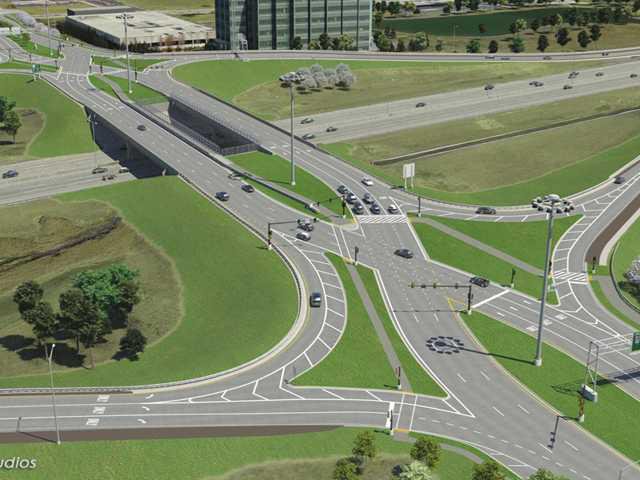Motorists getting on and off Union Road at the 120 Bypass will never have to worry about their turn movements being stopped by a red light sometime in 2018 if Manteca becomes the first California city to employ a diverging diamond interchange.
Caltrans is conducting a public meeting on Thursday, Oct. 20, from 6 to 7:30 p.m. to explain the project and field questions. The meeting, that includes a presentation at 6:30 p.m., is taking place at the Manteca Civic Center. 1001 W. Center St. More information about Thursday’s meeting can be found in an ad on Page A3 of today’s Bulletin.
The project will also include Manteca’s first separated pedestrian/bicycle bridge across the 120 Bypass to address growing concerns about safety as more and more walkers head across Main Street, Union Road, and Airport Way as housing develops south of the 120 Bypass. None of the existing overpasses have sidewalks or protected bicycle lanes. The diverging diamond design as employed in other states require pedestrians to cross into the middle of the bridge and then cross back to the edge at two signalized intersection.
Manteca opted to pursue a diverging diamond interchange for Union Road instead of upgrading the existing structure to a partial cloverleaf.
The diverging diamond design calls for traffic lanes crossing each other on either side of the bridge structure so northbound traffic would cross the bridge on the west side instead of the east side with the southbound lanes on the east side instead of the west side. Once they clear the bridge they are switched back.
The on and off ramps along with the flipping of the lanes creates two semi-diamond shaped intersections on either side of the bridge. This eliminates the need for traffic from both directions on Union Road as well as that coming from the 120 Bypass to avoid needing any traffic signals to exit an off ramp or to get onto an on ramp. The project will also include ramp meter signals such as now are in place on the Lathrop Road/Highway interchange.
The design could slash as much as $10 million from the $25 million estimated cost of converting Union Road into a partial cloverleaf.
The council last November opted to put pedestrian safety on equal footing with traffic flow by including what could be a $1.5 million pedestrian/bicycle path that would eliminate the need for either to have to cross off- and on-ramp traffic or pedal alongside traffic moving at 40 mph in order to cross the 120 Bypass.
It would involve building a tunnel under off and on ramps on the east side of the bridge and looping a shared two-lane bicycle/pedestrian path up to the overcrossing where a wall would separate it from the traffic lanes. The Class I bicycle path would be American with Disabilities compliant. It also would have stairs that would allow walkers wanting to — and able to do so— to take a shortcut bypassing the loop to reach the bridge deck.
Staff — in order to cut costs — had proposed directing pedestrian and bicyclist into a path in the middle of six lanes of traffic protected by railing or concrete K-rail — in order to cross the 120 Bypass as part of a diverging diamond design. That would have required bicyclists and pedestrians to cross traffic four times to get across the 120 Bypass.
There are diverging diamond designs that keep the bike lane and sidewalk or separated bike path for bicyclists and pedestrians to share on both sides of the crossing. In doing so, pedestrians and bicyclists are left to cross traffic turning into and off the freeway without protection of traffic lights. If traffic lights were added it would defeat the purpose of eliminating stops for vehicles and not increase the volume that the ramps could handle.
The new overpass is being funded with money collected from growth as well as unspent redevelopment agency funds that were earmarked for the Union Road project.
Advantages of a diverging diamond interchange according to Advanced Transportation Solutions/American are:
Fewer conflict points (14 for diverging diamond design, 26 for conventional design).
Better sight distance at turns.
Traffic calming features when desired.
Additional right of way is rarely needed.
Virtually no driver confusion based on a study and observation of existing diverging diamond design interchanges.
Construction time is reduced.
Wrong way entry to ramps extremely difficult.
Pedestrian crossings are shorter.
Maintenance of traffic is simplified during construction.
There are 57 such interchanges now in place in the United States. The closest is in Reno on Interstate 580 at Moana Lane.
Caltrans is considering a diverging diamond for a proposed interchange improvements in Ceres along Highway 99. The project in Ceres, though, isn’t expected to move forward until 2020.
To contact Dennis Wyatt, email dwyatt@mantecabulletin.com
DIVERGING DIAMOND
A Manteca motorists best friend?





